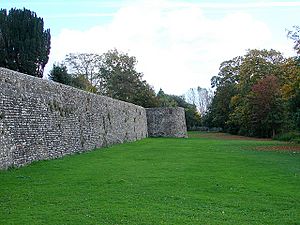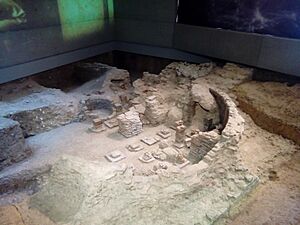Noviomagus Reginorum facts for kids
Noviomagus Reginorum was the Roman name for what is now Chichester. It was a very important Roman town in Roman Britain. Not much of the original Roman town can be seen above ground today. It was located in the area of the Atrebates, a local tribe who were friendly with the Romans. The town is in the county of West Sussex, near the English Channel and Chichester Harbour.
Contents
What's in a Name?
The name Noviomagus Reginorum is actually a modern name given to the Roman town. It was put together by historians using old records.
The first part, Noviomagus, means 'new market' or 'new plain'. Many Roman towns across the empire had this name. The second part, Reginorum, refers to the Regni people. These were the local tribe who lived in the area and worked with the Romans.
A Roman Town's Story
Noviomagus Reginorum started as a winter camp for the Second Augustan Legion, a Roman army group. This happened shortly after the Romans invaded Britain in AD 43. The camp was led by Vespasian, who later became a Roman emperor. Soldiers lived in timber barracks, and there were places to store supplies.
After only a few years, the army moved on. The camp then grew into a civilian town, meaning ordinary people lived there, not just soldiers.
Important Leaders and Buildings
The town became the capital of the Civitas Reginorum. This was a special area ruled by Tiberius Claudius Cogidubnus. He was a local king who worked closely with the Romans. Many historians believe he lived in the grand Fishbourne Roman Palace, which is about a mile west of Chichester.
Noviomagus Reginorum had many important public buildings:
- A temple dedicated to the Roman gods Neptune and Minerva. An inscription from this temple, found in 1723, mentions Cogidubnus.
- Public baths were located under what is now Tower Street.
- An amphitheatre (a large outdoor arena) was near the cattle market.
- A basilica, which was like a large public hall or town hall, is thought to have been where Chichester Cathedral stands today.
The town grew into a busy center for people to live, trade, and make goods. They produced fine pottery and enamel work. In the second century, the town was protected by a bank and a wooden fence, which was later rebuilt using stone. Stronger towers called Bastions were added in the early fourth century. The town also got better roads and a new sewer system. There were cemeteries (burial grounds) outside the town's east, north, and south gates.
The Town's End
By the AD 380s, it seems Noviomagus was mostly empty. This might have been because of raids by the Anglo-Saxons along the south coast.
According to an old book called the Anglo-Saxon Chronicle, the town was eventually captured by the legendary Ælle of the South Saxons in the late fifth century. He supposedly renamed it Chichester after his son Cissa. However, archaeological findings suggest that Anglo-Saxons didn't settle in the city until the ninth century.
What's Left Today?
Even though much of Noviomagus Reginorum is gone, you can still see some parts of it:
- A piece of a beautiful Roman mosaic can be seen under the floor of Chichester Cathedral.
- Another mosaic from Noviomagus is on display at Fishbourne Roman Palace.
- One of the town's old Bastions can be found in the gardens of the Bishop's Palace.
- Chichester's museum, The Novium, has many items found from the Roman town. It even has the remains of a Roman bathhouse that you can see.




